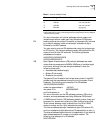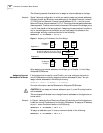
Learning About the User Interfaces 33
Table 6 Internet Address Format
Class Range of First Address Field Address Format
A 0–127 nnn.hhh.hhh.hhh
*
* n represents a digit of the network number; h represents a digit of the host number.
B 128–191 nnn.nnn.hhh.hhh
*
C 192–223 nnn.nnn.nnn.hhh
*
D 224–239 yyy.yyy.yyy
†
† Class D addresses are used for multicast applications as assigned by the Internet Assigned
Numbers Authority (IANA).
For more information on Internet addresses, subnet masks, and
variable length subnet masks, see Using Enterprise OS Software.
IPX Leading zeros can be omitted. Consists of an ampersand (&) followed
by a network address, which contains eight hexadecimal digits,
followed by the MAC address.
You may need to enter an IPX address when using the bridge/router
for IPX routing. The network address uniquely distinguishes one IPX
network from all other IPX networks. The following example
addresses are the same:
&00003333%080002005678
&3333%080002005678
OSI Open System Interconnection (OSI) network addresses are called
network service access points (NSAPs). NSAPs are of variable length
and format, although they are always considered to have the
following three parts:
■ Area address (variable length)
■ System ID (six octets)
■ N-selector (one octet)
The system ID and N-selector are the last seven octets of the MAC
address, and the area address is everything but the system ID and
N-selector. The following is an example of an OSI address:
/49/0053080002A0089D01
where the area address is: /49/0053
the system ID is: 080002A0089D
and the N-selector is: 01
For more information on the OSI addressing scheme, OSI routing
domains, and area addresses, see Using Enterprise OS Software.
VIP A VINES Internet Protocol (VIP) address is globally unique, fixed, and
permanent for servers and routers only. Each node has a two-field,
48-bit Internet address, which is derived from the 32-bit VINES
network number and the 16-bit subnetwork number.
The Internet address has eight hexadecimal digits (VIP network ID)
and four hexadecimal digits (subnetwork ID) separated by a colon (:).
The Internet address (logical network) is independent of any data link
layer address assigned to a node on a physical medium. The
following is an example of a VIP address:
02A01339:0001


















